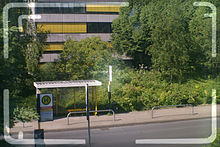Bright line viewfinder
The bright line viewfinder is used in viewfinder cameras , also with interchangeable or zoom lenses.
Viewfinder cameras are characterized by three fundamental problems:
- The optical axis of the viewfinder and lens are not congruent; parallax occurs, which is particularly noticeable at close range (approx. <1 m for normal focal lengths ). Some viewfinders compensate for this by mechanical adjustment or auxiliary markings.
- The viewfinder is also independent of the lens in terms of its focal length, so that it usually shows a larger section. Some optical viewfinders on cameras with a fixed zoom lens adjust the image section to the set focal length , the viewfinder itself "zooms". However, this automatic adjustment fails when using wide-angle or tele-attachments or filters. Some older view finders have an adjustable mechanical limitation of the field of view as an adjustment to the respective focal length.
- In contrast to cameras with a focusing screen ( focusing screen) and / or reflex viewfinder , no direct assessment of the image sharpness and depth of field is possible. Many viewfinder cameras with manual focus therefore have a depth of field scale for assessing the focus area, from which one can read off the extent of the focus area depending on the aperture setting.
The bright-line frame in the viewfinder remedies these disadvantages, at least partially; he shows the photographer the detail that will later be shown on the negative or slide .
Optical viewfinders also have advantages:
- The viewfinder image is always optimally bright , regardless of the light intensity of the lens used.
- In connection with a mixed image rangefinder , focusing is also easily possible with low-light lenses or in very unfavorable lighting conditions.
- The power requirement of the display in digital cameras is eliminated, batteries and rechargeable batteries last longer. Often no battery is required to keep a mechanical camera on standby.
- With medium format cameras, a reflex construction is rather complex. Double-lens reflex cameras use a second, parallel focusing and mostly optically simpler, more powerful lens as a viewfinder. The SLR construction with movable mirror is limited to professional cameras and a Polaroid construction. This is almost unknown in large format cameras; focusing screens and viewfinders replace them.
- Cameras in the short focal length range can be more easily constructed in the form of a viewfinder camera due to the lens-film carrier spacing and the lens design possible with it.
- Mechanical viewfinders allow a wider, sometimes not limited viewing angle and thus a better understanding of a fast-moving object.
In the case of single-lens reflex cameras , the viewfinder beam path runs directly through the lens so that the photographer can precisely assess the subsequent image section. There is no parallax, more precise work is possible in the macro and telephoto ranges.
Compact digital cameras also show the exact image section on the built-in LC display , as the data from the image sensor are processed directly. In many models, the optical viewfinder has been rationalized away in favor of the largest possible display.
Technically, illuminated frame viewfinders are related to the reflex sights on firearms and the head-up displays on aircraft.


